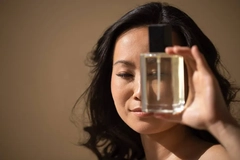Optimal surfactant ratio identified for improved hair care formulations

A study has found an “optimal” formulation balance between anionic surfactants, a cleansing agent, and guar gum in hair care products. The balanced combination allows the mixture to stick to wet hair, protect and condition hair, and can be used as a formulation tool to improve overall product performance.
Cationic guar gum is a widely used biopolymer by formulators due to its compatibility with various formulations and its conditioning properties. Meanwhile, anionic surfactants are the primary cleansing agents in shampoos, known to generate foam and cleanse the scalp.
“Our findings provide a deeper understanding of how cationic guar gum interacts with different anionic surfactants under controlled conditions,” Dr. Sergio Alberto Bernal-Chávez, co-author of the study and professor and researcher at the Department of Chemical and Biological Sciences, University of the Americas, Mexico, tells Personal Care Insights.
He says that by identifying the optimal ratios that lead to stable and well-structured coacervates, formulators can design hair care products with improved deposition, adhesion, and conditioning performance. Additionally, the findings eliminate the need for trial-and-error developments.
“By optimizing polymer–surfactant ratios, products can achieve better cuticle coverage, higher adhesion to damaged areas, and more uniform protective films. This translates into tangible benefits such as improved softness, manageability, and long-term conditioning effects for consumers.”
“Our work emphasizes that coacervation is not merely a physicochemical phenomenon but a powerful formulation tool. By leveraging the balance of electrostatic, hydrogen bonding, and hydrophobic interactions, the cosmetic industry can design next-generation hair care products that are more effective, milder, and sustainable.”
Breaking down the details
The study, published in the International Journal of Cosmetics Science, characterizes healthy hair by its shine, smooth texture, and structural integrity and investigates the optimal coacervation formulation.
It stresses that anionic surfactant performance is based on how it interacts with other components. Its interplay with cationic polymers often results in the formation of coacervates, “which are phase-separated complexes formed between oppositely charged molecules in solution,” the study explains.
 Anionic surfactant performance is based on how it interacts with other components.The experiments were conducted at lower surfactant concentrations to isolate the interaction mechanisms.
Anionic surfactant performance is based on how it interacts with other components.The experiments were conducted at lower surfactant concentrations to isolate the interaction mechanisms.
Bernal-Chávez says commercial shampoos typically contain 10–15% surfactants. “Scaling these findings to higher concentrations will require further work, but the molecular interactions demonstrated here suggest that the same principles will guide performance at real-world formulation levels.”
“We observed that milder surfactants such as sodium lauryl sulfoacetate and sodium cocoyl isethionate generated more structured and adhesive coacervates compared to traditional sulfates like SLS (sodium lauryl sulfate).”
“This suggests that sulfate-free systems, when properly balanced with cationic polymers, remain feasible and can enhance deposition efficiency and hair conditioning benefits, aligning with current industry shifts toward gentler cleansing systems.”
He adds that the study demonstrates that coacervate formation is not simply a by-product of formulation but a tunable mechanism that directly impacts deposition on hair fibers.
Improving the feel and rinse-off
Bernal-Chávez tells us the sensory evaluations confirmed that optimized coacervates enhanced spreadability and adhesion while avoiding excessive stickiness.
“These properties are directly linked to how products feel during application and rinse-off. A balanced formulation ensures efficient deposition on hair while leaving minimal residue, thus improving consumer sensorial experience and product performance,” he says.
 Bernal-Chávez notes that using plant-derived polymers and sustainable surfactants contributes to eco-friendlier product profiles.Bernal-Chávez highlights that milder surfactants are compatible and may be advantageous in coacervate-based systems. He explains that to achieve a milder and more sustainable surfactant in hair care, the superior coacervate stability and deposition were achieved with SCI (sodium cocoyl isethionate) and SLSA (sodium lauryl sulfoacetate).
Bernal-Chávez notes that using plant-derived polymers and sustainable surfactants contributes to eco-friendlier product profiles.Bernal-Chávez highlights that milder surfactants are compatible and may be advantageous in coacervate-based systems. He explains that to achieve a milder and more sustainable surfactant in hair care, the superior coacervate stability and deposition were achieved with SCI (sodium cocoyl isethionate) and SLSA (sodium lauryl sulfoacetate).
This supports the transition toward sustainable formulations that reduce irritation potential while delivering strong conditioning and protective effects. The results reinforce the viability of replacing harsher sulfates without compromising product quality.
“By demonstrating that lower concentrations of milder, biodegradable surfactants can achieve efficient deposition when paired with natural polymers like cationic guar gum, our study supports the design of formulations that reduce environmental impact,” says Bernal-Chávez.
To further reduce impact, Bernal-Chávez notes that using plant-derived polymers and sustainable surfactants contributes to eco-friendlier product profiles, aligning with consumer and regulatory demands for greener cosmetic technologies.
“Importantly, these findings bridge fundamental science with practical formulation strategies, opening the door to innovation in sulfate-free and polymer-enhanced systems.”












